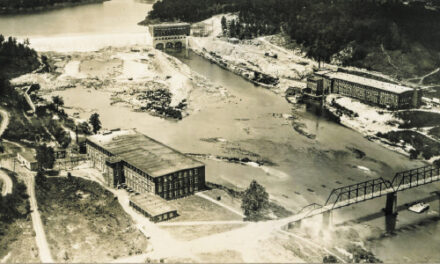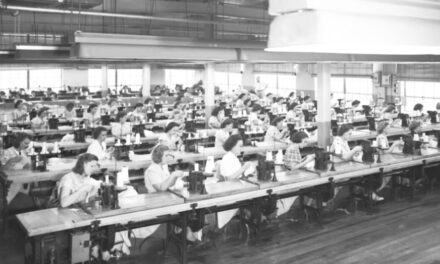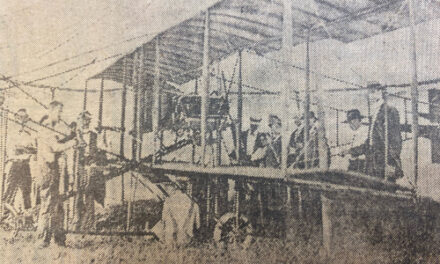
What was it like to go through the largest natural catastrophe ever seen in this region? Sherrie Hartsoe Sigmon lets us in on how folks in Rhodhiss saw and remembered the deluge. – Richard Eller

Photo: 1916 Flood in Rhodhiss. The warehouse washed away along with many other buildings.
In July 1916 two back-to-back hurricanes caused destruction to western North Carolina. Rhodhiss was a victim, and devastation was widespread as residents and newspapers detailed this disaster.
The Lenoir News-Topic stated, “At the river the big railroad bridge is washed away, and it is thought that the several miles of track between the bridge and Cliffs station is washed away. On this side of the river the Rhodhiss depot, several box cars loaded with cotton and about a half a mile of track were washed away.” Rhodhiss was described as “desolate and destitute.” Water reached the second and third stories of both mills. Four hundred bales of cotton floated away, and a $50,000 shipment of finished cotton that was in the warehouse drifted away. The two Rhodhiss plants sustained over $100,000 in damages.
People flocked to the mill village to watch dams, trestles, bridges, crops, pigs, cattle, horses, chicken coops, sheds, barns, houses, cotton bales, lumber, and automobiles glide down the river. According to the Hickory Daily Record, in Mortimer more than 30 houses floated away when this area received over 36 inches of rain in 36 hours. Telephone and telegraph lines were also damaged.
Violet Curtis, who lived in Rhodhiss, gave her firsthand account: “I remember going down there in the rain, and limbs were in the water. People had poles with nails to pull lumber out of the water. Way up there near Strawberry Hill in that curve, it backed up in that island. Now, my sister Ruth who was just a baby was getting close to that water, and Mama said, ‘I’m not coming down here again. It could jerk Ruth in there. ’You know they found a pig in the old mill in the quill room. I remember my daddy had boots on from wading to get the cloth out of the weave shop. The livery stable washed away. That was a pitiful time.”
Gladys Barker elaborated: “It rained all day on Saturday; the bridge and depot washed away along with three houses on Saturday afternoon late. Employees including my dad worked till midnight moving cloth to the top floor of the plants to save it. Papa worked on the Burke side and needed to get to Caldwell side, so he and others went to the trestle and crossed there with water coming over. My family and I didn’t know until the next morning how dangerous it had been for Papa.”
Mattie Munday said, “I remember going down there during the flood, and water was all up in the mill. Along there about where the warehouse was little fish washed up in there, and a boy was catching fish by hand. My older brother was so anxious about living there after the flood that he wanted us to get life insurance so we wouldn’t ever die.”
The 1916 flood brought despair throughout western North Carolina. With the hard work of the mill workers and owners, Rhodhiss was able to recoup the losses.








